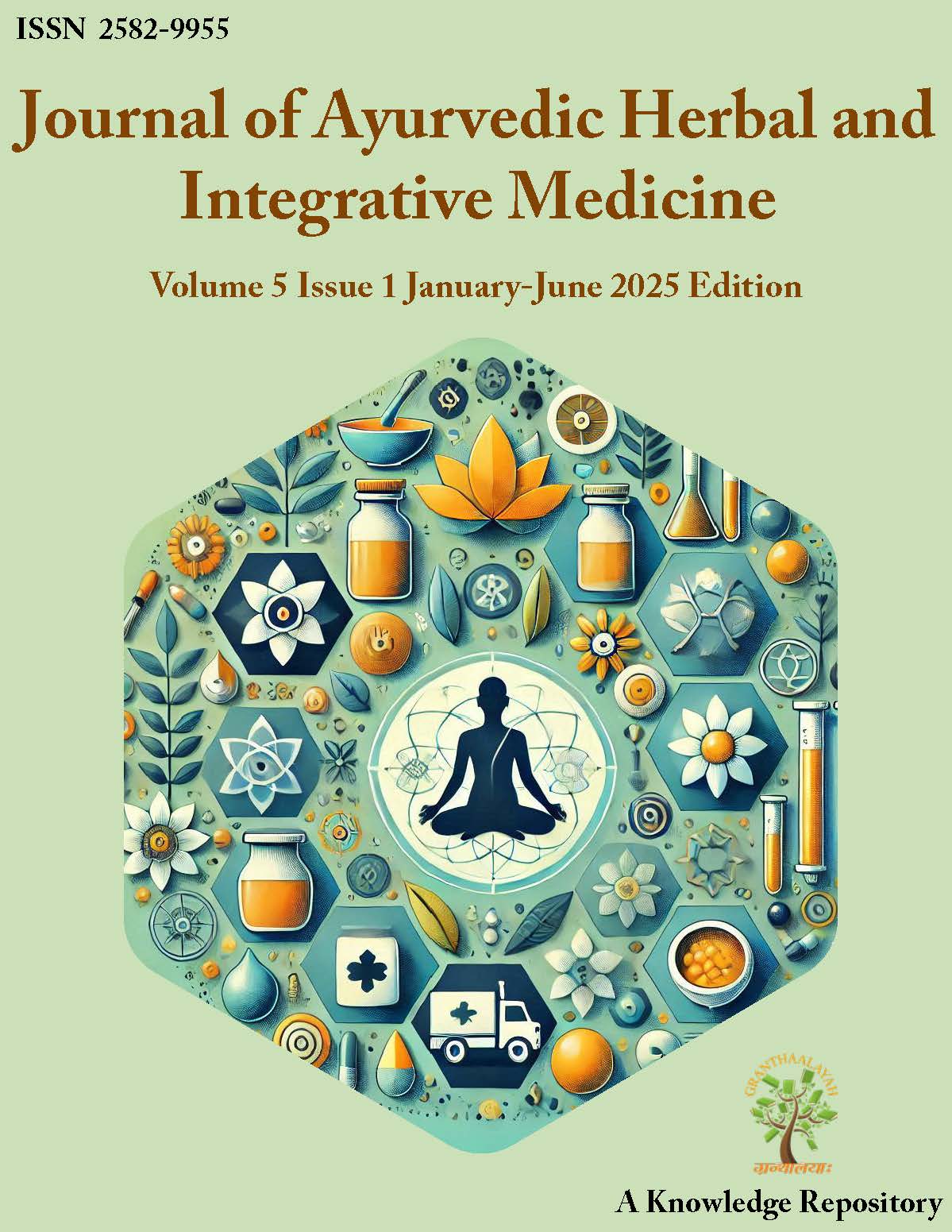THE PHARMACOLOGICAL AND ADVERSE EFFECTS OF THE BETEL NUT ON EXPERIMENTAL ANIMALS- A REVIEW
DOI:
https://doi.org/10.29121/jahim.v5.i1.2025.63Keywords:
Experimental Animals, Animal Models, Betel NutAbstract [English]
Betel nut is a well-known plant product consumed mostly by people in Asian countries. Betel nut chewing seems significantly associated with susceptibility to oral, oesophageal, stomach, liver and lung cancers. Moreover, betel nut extracts at different concentrations induce significant genetic damage and histological abnormalities in the testis in tumour-bearing mice. The genotoxic and carcinogenic potentiality of betel nut extracts has been studied in different animal models. Therefore, our present review will discuss the mutagenic, carcinogenic and angiogenic effects of betel nut on animal model.
References
Ahuja, S. C., & Ahuja, U. (2011). Betel leaf and betel nut in India: History and uses. Asian Agri-History, 15(1), 13-35.
Anand, R., Dhingra, C., Prasad, S., & Menon, I. (2014). Betel Nut Chewing and its Deleterious Effects on oral Cavity. Journal of Cancer Research and Therapeutics, 10(3), 499-505. https://doi.org/10.4103/0973-1482.137958
Awang, M. N. (1986). Estimation of Arecoline Contents in Commercial Areca (betel) Nuts and its Relation to Oral Precancerous Lesions. Singapore Medical Journal, 27(4), 317-320.
Aziz, S. R. (2010). Coming to America: Betel Nut and Oral Submucous Fibrosis. Journal of the American Dental Association, 141(4), 423-428. https://doi.org/10.14219/jada.archive.2010.0194
Banerjee, S., Rajadurai, S., & Nayudamma, Y. (1961). Occurrence of D-Catechin and a Flavan-3, 4-diol in Areca nut. Bulletin of the Central Leather Research Institute, 8, 174.
Basu, S., Roy Choudhury, U., Das, M., & Datta, G. (2013). Identification of Bioactive Components in Ethanolic and Aqueous Extracts of Amorphophalus Campanulatus Tuber by GC-MS Analysis. International Journal of Phytomedicine, 5(2), 243-251.
Bernstein, N., Akram, M., Yaniv-Bachrach, Z., & Daniyal, M. (2021). Is it Safe to Consume Traditional Medicinal Plants During Pregnancy? Phytotherapy Research, 35(4), 1908-1924. https://doi.org/10.1002/ptr.6935
Bhisey, R. A., Ramchandani, A. G., D'Souza, A. V., Borges, A. M., & Notani, P. N. (1999). Long-term Carcinogenicity of Pan Masala in Swiss Mice. International Journal of Cancer, 83, 679-684. https://doi.org/10.1002/(SICI)1097-0215(19991126)83:5<679::AID-IJC19>3.0.CO;2-E
Blank, M., Deshpande, L., & Balster, R. L. (2008). Availability and Characteristics of Betel Products in the U.S. Journal of Psychoactive Drugs, 40(3), 309-313. https://doi.org/10.1080/02791072.2008.10400646
Bonassi, S., Znaor, A., Norppa, H., & Hagmar, L. (2004). Chromosomal Aberrations and Risk of Cancer in Humans: An Epidemiologic Perspective. Cytogenetic and Genome Research, 104, 376-382. https://doi.org/10.1159/000077519
Changrani, J., Gany, F. M., Cruz, G., Kerr, R., & Katz, R. (2006). Paan and Gutka use in the United States: A Pilot Study in Bangladeshi and Indian-Gujarati Immigrants in New York City. Journal of Immigrant & Refugee Studies, 4(1), 99-110. https://doi.org/10.1300/J500v04n01_07
Chen, W. (2009). Association between Betel-Nut Chewing and Chronic Kidney Disease in men. Public Health Nutrition, 12(5), 723-727. https://doi.org/10.1017/S1368980008003339
Cheong, Y. H. (1984). The fading links between tradition and oral health in Singapore. International Dental Journal, 34(4), 253-256.
Chin, C. T., & Lee, K. W. (1970). The Effects of Betel-Nut Chewing on the Buccal Mucosa of 296 Indians and Malays in West Malaysia: A clinical study. British Journal of Cancer, 24(3), 427-432. https://doi.org/10.1038/bjc.1970.50
Chou, C. Y., Cheng, S. Y., Liu, J. H., Cheng, W. C., Kang, I. M., Tseng, Y. H., Shih, C. M., &...(n.d)
Chowdhury, S. (2023). Genotoxic and Carcinogenic Potential of Ethanolic Extract of Betel Nut on Experimentally Induced Tumour in Mice. PhD Thesis, University of Calcutta.
Chowdhury, S., & Banerjee, S. (2020). Evaluation of Genotoxic and Carcinogenic Potentiality in Betel Nut Extract Treated Sarcoma-180 Tumor Bearing Mice. Journal of Advanced Scientific Research, 11(Suppl 5), 32-40.
Chowdhury, S., & Banerjee, S. N. (2021). Genotoxic Activity of Betel nut on Germinal Cell in Sarcoma 180 Ascites Tumour Bearing Male Mice. GSC Biological and Pharmaceutical Sciences, 16(3), 121-134. https://doi.org/10.30574/gscbps.2021.16.2.0235
Chowdhury, S., Banerjee, A., Mallick, S., & Banerjee, S. N. (2019). Cytotoxic Effect of Betel Nut on Seminal Fluid Fructose Concentration and Sperm Motility of Normal Male Mice. RJLBPCS, 5(1), 378-389.
Chu, N. S. (2001). Effects of Betel Chewing on the Central and Autonomic Nervous Systems. Journal of Biomedical Science, 8(3), 229-236. https://doi.org/10.1007/BF02256596
Chu, N. S. (2002). Neurological Aspects of Areca and Betel Chewing. Addiction Biology, 7(1), 111-114. https://doi.org/10.1080/13556210120091473
Dave, B. J., Trivedi, A. H., & Adhvaryu, S. G. (1992). In Vitro Genotoxic Effects of Areca nut Extract and Arecoline. Journal of Cancer Research and Clinical Oncology, 118(4), 283-288. https://doi.org/10.1007/BF01208617
Eswar, N. (2002). Oral health status among the tobacco and betel nut chewers in the Kishore Ganj District of Bangladesh: A statistical study. Indian Journal of Dental Research, 13(3-4), 167-171.
Gao, Y., Ling, T., & Wu, H. (1997). [Title in Chinese]. Zhonghua Kou Qiang Yi Xue Za Zhi, 32(4), 239-241.
Garg, A., Chaturvedi, P., & Gupta, P. C. (2014). A Review of the Systemic Adverse Effects of Areca Nut or Betel nut. Indian Journal of Medical and Paediatric Oncology, 35*(1), 3-9. https://doi.org/10.4103/0971-5851.133702
Gupta, P. C., & Warnakulasuriya, S. (2002). Global Epidemiology of Areca nut usage. Addiction Biology, 7(1), 77-83. https://doi.org/10.1080/13556210020091437
Howden, G. F. (1984). The Cariostatic Effect of Betel Nut Chewing. Papua and New Guinea Medical Journal, 27(3-4), 123-131.
IARC Working Group on the Evaluation of Carcinogenic Risks to Humans. (2004). Betel-quid and areca-nut chewing and some areca-nut derived nitrosamines. *IARC Monographs on the Evaluation of Carcinogenic Risks to Humans, 85, 1-334.
IARC Working Group on the Evaluation of Carcinogenic Risks to Humans. (2012). Personal habits and indoor combustions. *IARC Monographs on the Evaluation of Carcinogenic Risks to Humans, 100*(Pt E), 1-538.
IARC. (1985). IARC Monographs on the Evaluation of the Carcinogenic Risk of Chemicals to Humans, Vol. 37, Tobacco Habits Other than Smoking; Betel-Quid and Areca-nut Chewing; and Some Related Nitrosamines. Lyon, IARC Press.
Ikeda, N., Handa, Y., Khim, S. P., Durward, C., Axéll, T., Mizuno, T., Fukano, H., & Kawai, T. (1995). Prevalence study of oral mucosal lesions in a selected Cambodian population. Community Dentistry and Oral Epidemiology, 23*(1), 49-54. https://doi.org/10.1111/j.1600-0528.1995.tb00197.x
Inokuchi, J., Okabe, H., Yamauchi, T., Nagamatsu, A., Nonaka, G., & Nishioka, I. (1986). Antihypertensive Substance in Seeds of Areca Catechu L. Life Sciences, 38*(15), 1375-1382. https://doi.org/10.1016/0024-3205(86)90470-4
Jeng, J. H., Chang, M. C., & Hahn, L. J. (2001). Role of Areca Nut in Betel Quid-Associated Chemical Carcinogenesis: Current Awareness and Future Perspectives. Oral Oncology, 37(6), 477-492. https://doi.org/10.1016/S1368-8375(01)00003-3
Ji, W. T., Chuang, Y. C., Chen, H. P., Lee, C. C., Chen, J. Y., Yang, S. R., Chen, J. H., Wang, C. J., & Chen, H. R. (2014). Areca Nut Extracts Exert Different Effects in Oral Cancer Cells Depending on Serum Concentration: A clue to the Various Oral Alterations in betel Quid Chewers. Toxicology Reports, 1, 1087-1095. https://doi.org/10.1016/j.toxrep.2014.10.018
Jussawalla, D. J., & Deshpande, V. A. (1971). Evaluation of Cancer Risk in Tobacco Chewers and Smokers: An Epidemiologic Assessment. Cancer, 28*, 244-252. https://doi.org/10.1002/1097-0142(197107)28:1<244::AID-CNCR2820280150>3.0.CO;2-H
Kasparek, T. R., & Humphrey, T. C. (2011). DNA Double-Strand Break Repair Pathways, Chromosomal Rearrangements and Cancer. Seminars in Cell and Developmental Biology, 22, 886-897. https://doi.org/10.1016/j.semcdb.2011.10.007
Kozlakidis, Z., Cheong, I. H., & Wang, H. (2022). Betel Nut and Arecoline: Past, Present, and Future Trends. Innovations in Digital Health, Diagnostics, and Biomarkers. https://doi.org/10.36401/IDDB-22-05
Lin, W. Y., Pi-Sunyer, F. X., Liu, C. S., Li, T. C., Li, C. I., Huang, C. Y., & Lin, C. C. (2009). Betel Nut Chewing is Strongly Associated with General and Central Obesity in Chinese Male Middle-Aged Adults. Obesity, 17(6), 1247-1254. https://doi.org/10.1038/oby.2009.38
Liu, P. F., & Chang, Y. F. (2023). The Controversial Roles of Areca Nut: Medicine or toxin? International Journal of Molecular Sciences, 24(10), 8996. https://doi.org/10.3390/ijms24108996
Lord, G. A., Lim, C. K., Warnakulasuriya, S., & Peters, T. J. (2002). Chemical and Analytical Aspects of Areca nut. Addiction Biology, 7(1), 99-102. https://doi.org/10.1080/13556210120091455
Mathew, A. G., Venkataramu, S. D., & Govindarajan, V. S. (1964). Studies on areca nut: Part 1- Changes in chemical and physical characteristics of nuts with maturity. Indian Journal of Technology, 2, 90-95.
Mazahir, S., Malik, R., Maqsood, M., Merchant, K. A., Malik, F., Majeed, A., Fatmi, Z., Khawaja, M. R., & Ghaffar, S. (2006). Socio-demographic correlates of betel, areca and smokeless tobacco use as a high risk behavior for head and neck cancers in a squatter settlement of Karachi, Pakistan. *Substance Abuse Treatment, Prevention, and Policy, 1, 10. https://doi.org/10.1186/1747-597X-1-10
Meng, M. L. (1969). La chique de bétel [The quid of betel]. Revue de Stomatologie et de Chirurgie Maxillo-Faciale, 70(6), 417-430.
Mortazavi, H., Baharvand, M., & Mehdipour, M. (2014). Oral Potentially Malignant Disorders: An Overview of more than 20 Entities. Journal of Dental Research, Dental Clinics, Dental Prospects, 8(1), 6.
Mubarokah, W. W., Nurcahyo, W., Prastowo, J., & Kurniasih, K. (2019). In Vitro and in Vivo Areca Catechu Crude Aqueous Extract as an Anthelmintic Against Ascaridia Galli Infection in cHickens. Veterinary World, 12(6), 877-882. https://doi.org/10.14202/vetworld.2019.877-882
Nagrajan, G. R., & Seshadri, T. R. (1961). Leucocyanidins of areca nut and toon (Cedralatoona Roxo). Journal of Scientific and Industrial Research (India), 20(B), 615-616.
Nair, U., Bartsch, H., & Nair, J. (2004). Alert for an Epidemic of Oral Cancer Due to use of the Betel Quid Substitutes Gutkha and Pan Masala: A review of Agents and Causative Mechanisms. Mutagenesis, 19(4), 251-262. https://doi.org/10.1093/mutage/geh036
Nigam, P., & Srivastava, A. B. (1990). Betel chewing and dental decay. Federation of Operative Dentistry, 1(1), 36-38.
Nisar, N., Qadri, M. H., Fatima, K., & Perveen, S. (2007). A Community Based Study about Knowledge and Practices Regarding Tobacco Consumption and Passive Smoking in Gadap Town, Karachi. JPMA: Journal of the Pakistan Medical Association, 57(4), 186-188.
Oakley, E., Demaine, L., & Warnakulasuriya, S. (2005). Areca (betel) Nut Chewing Habit Among High-School Children in the Commonwealth of the Northern Mariana Islands (Micronesia). Bulletin of the World Health Organization, 83(9), 656-660.
Orr, I. M. (1933). Oral Cancer in Betel Nut Chewers in Travancore: Its Aetiology, Pathology, and Treatment. Lancet, 2, 575-580. https://doi.org/10.1016/S0140-6736(01)18622-8
Owen, D. H., & Katz, D. F. (2005). A Review of the Physical and Chemical Properties of Human Semen and the Formulation of a Semen Simulant. Journal of Andrology, 26(4), 459-469. https://doi.org/10.2164/jandrol.04104
Pankaj, C. (2010). Areca Nut or Betel Nut Control is Mandatory if India wants to Reduce the Burden of Cancer, Especially Cancer of the Oral Cavity. International Journal of Head and Neck Surgery, 1, 17-20. https://doi.org/10.5005/jp-journals-10001-1003
Petti, S., & Warnakulasuriya, S. (2018). Betel Quid Chewing Among Adult Male Immigrants from the Indian Subcontinent to Italy. Oral Diseases, 24(1-2), 44-48. https://doi.org/10.1111/odi.12768
Raghavan, V., & Baruah, H. K. (1958). Areca nut, India's Popular Masticatory History, Chemistry, and Utilisation. Economic Botany, 12, 315-325. https://doi.org/10.1007/BF02860022
Salehi, B., Konovalov, D. A., Fru, P., Kapewangolo, P., Peron, G., Ksenija, M. S., Cardoso, S. M., Pereira, O. R., Nigam, M., Nicola, S., Pignata, G., Rapposelli, S., Sestito, S., Anil Kumar, N. V., de la Luz Cádiz-Gurrea, M., Segura-Carretero, A., Mishra, A. P., Sharifi-Rad, M., Cho, W. C., Taheri, Y., ... Sharifi-Rad, J. (2020). Areca catechu: From Farm to Food and Biomedical Applications. Phytotherapy Research, 34(9), 2140-2158. https://doi.org/10.1002/ptr.6665
Schamschula, R. G., Adkins, B. R., Barmes, D. R., & Charlton, G. (1977). Betel Chewing and Caries Experience in New Guinea. Community Dentistry and Oral Epidemiology, 5, 284-286. https://doi.org/10.1111/j.1600-0528.1977.tb01015.x
Schoenfeld, C., Amelar, R. D., Dubin, L., & Numeroff, M. (1979). Prolactin, fructose, and Zinc Levels Found in Human Seminal Plasma. Fertility and Sterility, 32(2), 206-208. https://doi.org/10.1016/S0015-0282(16)44182-8
Sharan, R. N. (1996). Association of Betel nut with Carcinogenesis: A Review. Cancer Journal, 9, 13-19.
Sharan, R. N., Chanu, T. M., Chakrabarty, T. K., & Farsalinos, K. (2020). Patterns of Tobacco and E-Cigarette use Status in India: A Cross-Sectional Survey of 3000 Vapers in Eight Indian Cities. Harm Reduction Journal, 17(1), 21. https://doi.org/10.1186/s12954-020-00362-7
Sharan, R. N., Mehrotra, R., Choudhury, Y., & Asotra, K. (2012). Association of Betel Nut with Carcinogenesis: Revisit with a Clinical Perspective. PLoS One, 7(8), e42759. https://doi.org/10.1371/journal.pone.0042759
Shirzaiy, M., & Neshat, F. (2020). Effect of Areca Nut on Oral Health: A review. Journal of Research in Dental and Maxillofacial Sciences, 5(3), 1-6. https://doi.org/10.29252/jrdms.5.3.1
Stich, H. F. (1991). The Beneficial and Hazardous Effects of Simple Phenolic Compounds. Mutation Research, 259, 307-324. https://doi.org/10.1016/0165-1218(91)90125-6
Strickland, S. S. (2002). Anthropological Perspectives on use of the Areca Nut. Addiction Biology, 7(1), 85-97. https://doi.org/10.1080/13556210120091446
Talebi, A. R., Vahidi, S., Aflatoonian, A., Ghasemi, N., Ghasemzadeh, J., & Firoozabadi, R. D. (2012). Cytochemical Evaluation of Sperm Chromatin and DNA Integrity in Couples with Unexplained Recurrent Spontaneous abortions. Andrologia, 44(Suppl 1), 462-470. https://doi.org/10.1111/j.1439-0272.2011.01206.x
Tang, J. G., Jian, X. F., Gao, M. L., Ling, T. Y., & Zhang, K. H. (1997). Epidemiological Survey of Oral Submucous Fibrosis in Xiangtan City, Hunan Province, China. Community Dentistry and Oral Epidemiology, 25(2), 177-180. https://doi.org/10.1111/j.1600-0528.1997.tb00918.x
Tanwir, F., Altamash, M., & Gustafsson, A. (2008). Influence of Betel Nut Chewing, Dental Care Habits, and Attitudes on Perceived Oral Health Among Adult Pakistanis. Oral Health & Preventive Dentistry, 6(2), 89-94.
Travasso, C. (2013). Betel Quid Chewing is Responsible for Half of Oral Cancer Cases in India, finds study. BMJ, 347, f7536. https://doi.org/10.1136/bmj.f7536
Trivedy, C., Baldwin, D., Warnakulasuriya, S., Johnson, N., & Peters, T. (1997). Copper Content in Areca Catechu (betel nut) Products and Oral Submucous Fibrosis. Lancet, 349(9063), 1447. https://doi.org/10.1016/S0140-6736(97)24020-1
Warnakulasuriya, S., & Chen, T. H. H. (2022). Areca Nut and Oral Cancer: Evidence from Studies Conducted in Humans. Journal of Dental Research, 101(10), 1139-1146. https://doi.org/10.1177/00220345221092751
Wary, K. K., & Sharan, R. N. (1988). Aqueous Extract of Betel-Nut of North-East India Induces DNA-Strand Breaks and Enhances Rate of Cell Proliferation in Vitro. Journal of Cancer Research and Clinical Oncology, 114(6), 579-582. https://doi.org/10.1007/BF00398180
Wu, P. F., Chiang, T. A., Chen, M. T., Lee, C. P., Chen, P. H., Ko, A. M., Yang, K. J., Chang, P. Y., et al. (2010). A Characterization of the Antioxidant Enzyme Activity and Reproductive Toxicity in Male Rats Following sub-chronic Exposure to Areca Nut Extracts. Journal of Hazardous Materials, 178(1-3), 541-546. https://doi.org/10.1016/j.jhazmat.2010.01.118
Yang, J., Wang, Z. Y., Huang, L., Yu, T. L., Wan, S. Q., Song, J., Zhang, B. L., & Hu, M. (2021). Do Betel Quid and Areca Nut Chewing Deteriorate Prognosis of Oral Cancer? A Systematic Review, Meta-Analysis, and Research Agenda. Oral Diseases, 27(6), 1366-1375. https://doi.org/10.1111/odi.13456
























